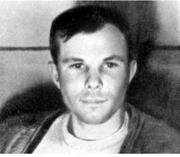The First Decade: 1961-1970
|
VOSTOK 1 |
|
|
Int. Designation |
1961 mu 1 |
|
Launched |
12 April 1961 |
|
Launch Site |
Pad 1 (later known as the Gagarinskiy Start or Gagarin Pad), Site 5, Baikonur Cosmodrome, Kazakhstan |
|
Landed |
12 April 1961 |
|
Landing Site |
30 km southwest of Engels, near Smelovako, Saratov |
|
Launch Vehicle |
R7 (8K72K serial #E103-16); spacecraft serial number (11F63/3KA) #3 |
|
Duration |
108 min |
|
Callsign |
Kedr (Cedar) |
|
Objective |
First manned test of Vostok spacecraft and launch vehicle systems, procedures and profiles |
Flight Crew
GAGARIN, Yuri Alekseyevich, 27, Soviet Air Force, pilot
Flight Log
12 April 1961 dawned a fine spring day at the Baikonur Cosmodrome. Yuri Gagarin and his back-up, Gherman Titov, awoke in their tiny log cabin alongside a second cottage where the home of their mentor, the space designer Sergei Korolyov had found it hard to sleep. The two were suited up in the MIK building nearby, and by 08: 50 Baikonur time were at Pad 1, exiting from a bus in which they had travelled with many fellow cosmonauts. Traditional hugs and kisses followed at the foot of the rocket, before Gagarin left Titov grounded. Gagarin was inside his capsule (known as the “sharik” – sphere) by 09: 10 hours.
Instruments indicated that the hatch had failed to seal properly, delaying the launch by seven minutes. At 11: 07 hours, the engines of the Vostok booster sprang to life, building up to full thrust, while from the nearby blockhouse, Korolyov bid Gagarin farewell. The booster clamps were released and the cosmonaut was airborne. “Poyekhali” (“Off we go”) Gagarin exclaimed as the rocket lifted off. The rocket’s ascent was excellently filmed from the launch pad and its shimmering shadow moving across the flat steppe land of Kazakhstan is one memorable shot from the now frequently shown film, which was strictly off-limits in the West until 1967.
By 11: 21 hours (09: 21 hours Moscow time, 06: 21 hours gmt) Gagarin was in orbit, a mere passenger on an automatic flight, in which even the retro-fire would be triggered from the ground. Manual control was possible but not planned for the flight. Indeed, the manual controls were locked on Vostok (East) 1 (the Russians do not officially number the first spacecraft of a new type, although Soyuz TMA1 in 2002 was designated as such) but could have been released in an emergency, provided Gagarin was radioed a three-digit code to give him control. Gagarin sent messages of goodwill
|
Yuri Gagarin, shortly after his pioneering flight into space on 12 April 1961 in Vostok, the first entry in the manned space flight log book |
and the unsurprising news that the Earth was “blue and the sky very, very dark.” Vostok, in its 65.07° inclination orbit (the highest inclination of a manned spacecraft to date), with a maximum altitude of 302 km (188 miles), sailed over the Pacific Ocean, South America and the Atlantic.
Over Africa, the retro-engine fired, initiating the re-entry, with the time on the clock at T + 1 hour 18 minutes into the flight, Moscow Radio having announced the launch just minutes earlier. The flight module initially did not separate cleanly, which could have resulted in the loss of Gagarin at the moment of his triumph. Fortunately the descent module did finally separate and made a 10-minute re-entry, ending at an altitude of 7 km (4 miles) with drogue parachute deployment. Gagarin ejected and reportedly landed close to bemused farm workers and a cow, 26 km (16 miles) southwest of Engels, near Smelovako, Saratov, at T + 1 hour 48 minutes, for the last 20 minutes of which Gagarin had not been aboard Vostok 1. The flight times of the Vostok cosmonauts and their capsules were released by Energiya in 2000. This revealed that the shariks landed about 10 minutes after the cosmonauts had parachuted to the ground. The time for Gagarin’s capsule was not revealed but this would imply that Gagarin’s “flight” landed at 1 hour 38 minutes – 98 minutes after launch. The fact that Gagarin had landed separately was not realised at the time in the West and not confirmed officially until 1978. Gagarin thus became the first of only six people so far – the Vostok pilots – to end a space flight without their spacecraft. Vostok 1 is also the shortest Soviet one-crew flight and the shortest manned orbital flight.
Milestones
1st manned space flight 1st Vostok manned flight
The next two flights after Gagarin were the two American sub-orbital flights by Alan Shepard on 5 May 1961, and Gus Grissom on 21 July 1961. Details of these flights can be found in the Quest for Space chapter.











